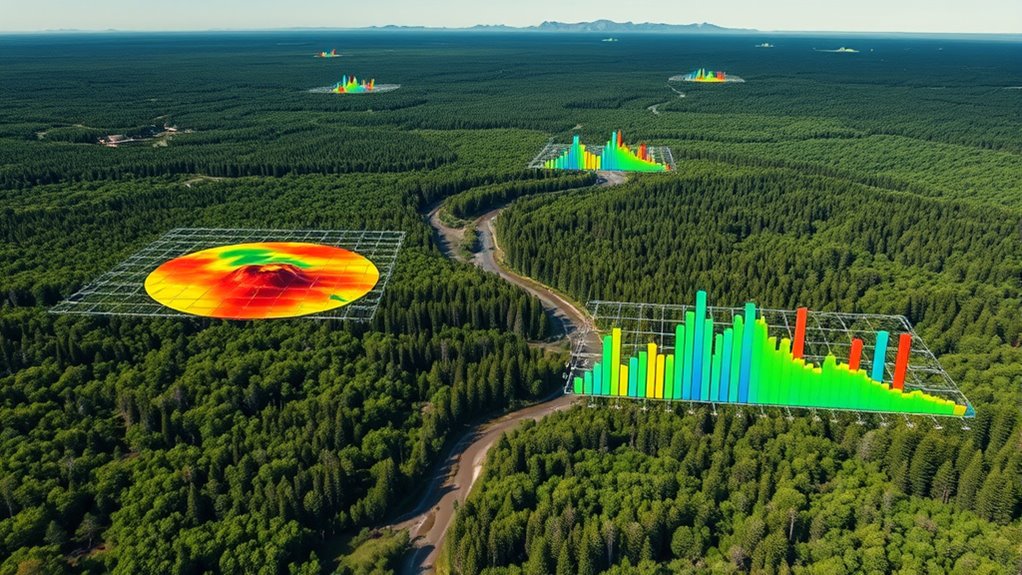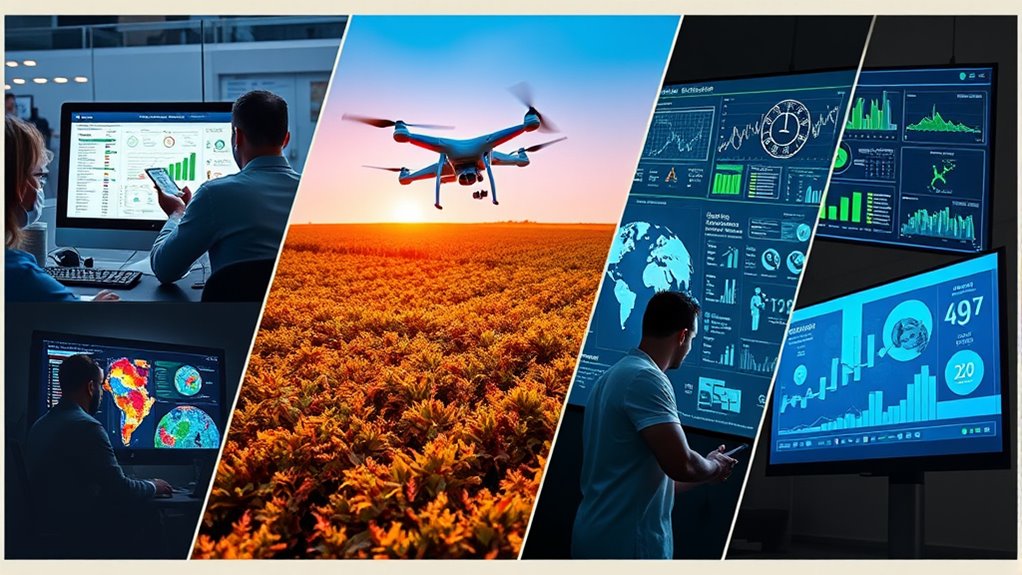Statistics help you make smarter decisions across many areas. Businesses use it to analyze sales, forecast trends, and improve operations. In healthcare, it guarantees research accuracy and guides public health strategies. Environmental agencies rely on it to track pollution and predict climate changes. Safety programs apply statistics to reduce crime and promote community well-being. Manufacturing firms use it to optimize processes and prevent failures. Keep exploring to discover how these applications impact your world even more.
Key Takeaways
- Business decision-making relies on statistical analysis of sales, customer feedback, and market trends for strategic planning.
- Medical research uses statistics to validate findings, determine sample sizes, and evaluate health interventions.
- Environmental monitoring employs sensors and data analysis to track pollution levels and predict climate changes.
- Crime prevention benefits from statistical data integration with community insights to develop targeted safety strategies.
- Manufacturing optimization utilizes real-time data analytics, predictive maintenance, and quality control to enhance efficiency.
Enhancing Business Decision-Making and Market Analysis

Statistics play an essential role in enhancing business decision-making and market analysis by providing data-driven insights that inform strategic choices. You can evaluate risks more effectively, predicting outcomes to guide investments and resource allocation.
Statistics are vital for informed business decisions and risk assessment.
Statistical tools help analyze sales data, customer feedback, and employee performance, highlighting areas for improvement. By examining market trends and historical data, you gain foresight into future conditions, enabling proactive strategies. Additionally, the use of statistical models can improve forecasting accuracy for various business metrics.
You can optimize operations, such as managing inventory levels and streamlining production processes, with the help of statistical models. Leveraging these insights gives you a competitive edge, allowing you to make informed decisions that enhance efficiency, reduce costs, and capitalize on market opportunities.
Additionally, understanding essential oil applications can provide unique marketing opportunities and product development ideas for health-conscious consumers. Ultimately, statistics empower you to make smarter, more confident business choices.
Advancing Medical Research and Public Health Initiatives

Building on how data analysis improves business decisions, applying rigorous statistical methods markedly advances medical research and public health efforts. Accurate statistics ensure research findings are valid, reliable, and reproducible, helping you draw correct conclusions. Proper statistical guidelines help you select suitable tests, determine correct group sizes, and avoid errors. In public health, you can use cross-sectional studies and tools like surveys to assess disease prevalence and health status. Statistical methods like t-tests, regression, and survival analysis enable you to evaluate interventions, predict health trends, and inform policies. When applied correctly, these techniques substantially improve the quality and impact of medical research and public health strategies. Additionally, understanding the importance of attention and deliberate practice can enhance the accuracy and depth of data collection and analysis, leading to more meaningful insights. Incorporating dream symbols and their interpretation can also aid in understanding patient experiences and mental health indicators, enriching research outcomes.
Improving Environmental Monitoring and Climate Predictions

Advancements in environmental monitoring technologies, such as digital sensors and pollution detection tools, play a essential role in collecting accurate data on air and water quality. These sensors are cost-effective, easy to install, and transmit data seamlessly, improving the reliability of environmental assessments. Incorporating dynamic communication exercises can further enhance the effectiveness of monitoring teams by fostering better collaboration and understanding. Monitoring networks like CASTNET and LTM track changes over time, providing fundamental information for climate prediction models and ecological evaluations. This data helps you understand pollution patterns, resource availability, and environmental impacts more precisely. Additionally, improvements in sensor accuracy contribute to more reliable data collection, enabling better decision-making for environmental management. As regulations become stricter, adopting advanced monitoring tools becomes indispensable for compliance and sustainable resource management. The continuous evolution of these technologies, driven by market growth and innovation, empowers you to make informed decisions about environmental policies and climate strategies.
Strengthening Safety Measures and Crime Prevention Strategies

To effectively strengthen safety measures and prevent crime, community engagement plays a crucial role. When you involve local residents, you create a network that monitors gangs and supports at-risk youth through mentoring programs like Big Brothers/Big Sisters.
Participating in afterschool activities keeps young people engaged and reduces juvenile crime. By collaborating with neighborhood non-profits, you can enhance services that lower violence—each additional ten nonprofits can cut violent crime by 14%.
Using participatory research, you combine crime data with community insights, developing targeted strategies. Your efforts in fostering strong community ties, combined with data-informed approaches, make neighborhoods safer. Additionally, understanding the importance of community-based initiatives can significantly increase the effectiveness of crime prevention efforts. Recognizing successful viral marketing campaigns can also boost awareness and community involvement in safety programs.
These proactive steps empower residents and create sustainable crime prevention, reducing violence and building resilient communities.
Optimizing Technology Development and Manufacturing Processes

Leveraging data and technology is transforming how manufacturing processes are developed and optimized. You can use real-time analytics to identify inefficiencies, reduce costs, and improve operational flow.
Industry 4.0 integrates cyber-physical systems and cognitive computing to create smart factories, boosting productivity through data-driven strategies.
Predictive maintenance helps forecast equipment failures, minimizing downtime and increasing efficiency.
Statistical methods like hypothesis testing allow you to pinpoint areas for process improvement, while automated sensors continuously monitor quality variations.
AI applications in quality control enhance product consistency by predicting and addressing flaws early, ensuring consistent output.
Furthermore, data analytics optimizes inventory and supply chain management, reducing delays and costs.
Understanding emotional support during times of change ensures that workforce wellbeing is maintained, fostering resilience and productivity.
These advancements enable ongoing process refinement, increasing productivity by up to 30%, and supporting the development of innovative manufacturing technologies. Incorporating advanced statistical techniques can further refine predictive models and decision-making processes.
Frequently Asked Questions
How Do Statistical Models Adapt to Rapidly Changing Market Conditions?
When you ask how statistical models adapt to fast-changing markets, you’re looking at their ability to learn continuously.
They update with new data, refine predictions, and incorporate emerging trends.
Using machine learning algorithms like neural networks and decision trees, they adjust their parameters in real time.
This flexibility helps you respond swiftly, manage risks effectively, and stay competitive by making informed decisions driven by up-to-date insights.
What Are the Limitations of Using Statistics in Medical Research?
You might think statistics always give clear answers in medical research, but they’ve limitations. Sometimes, your sample isn’t representative, leading to biased results. Small sample sizes reduce reliability, and choosing wrong statistical methods distorts findings.
Overlooking study limitations or misinterpreting p-values can mislead you. Additionally, publication bias and overemphasis on significance can skew understanding.
Always question the context and assumptions behind the numbers to guarantee meaningful, accurate conclusions.
How Accurate Are Climate Forecasts Based on Statistical Models?
You might find that climate forecasts based on statistical models aren’t as accurate as you’d hope, especially for complex phenomena like El Niño. Their skill drops during spring predictability barriers and for longer lead times.
While advancements like machine learning help, these models still struggle to predict specific events or seasonal variations. Overall, they perform better when combined with dynamical models, but there’s still room for improvement in precision.
Can Statistical Data Predict Rare or Unexpected Safety Incidents?
You might think statistical data can predict rare safety incidents accurately, but the truth is, it’s quite challenging. Rare events have limited data, making standard models less effective.
Still, advances like machine learning and deep learning improve predictions, especially when incorporating contextual info. You need substantial data and careful tuning, but even then, predictions aren’t foolproof due to the complex, chaotic nature of safety environments.
How Do Statistics Influence the Development of New Technological Innovations?
You see, statistics drive the development of new technologies by analyzing data to identify patterns and opportunities. They help refine product designs, assess risks, and predict market demands, enabling you to innovate efficiently.
Conclusion
By weaving statistics into the fabric of everyday life, you open a powerful lens to see through chaos and find clarity. Like a compass guiding sailors through stormy seas, these applications steer your decisions, innovations, and safety measures toward success. Embrace the art of data, and you’ll transform raw numbers into a symphony of insights, turning complexity into clarity and paving your way to a brighter, smarter future.










